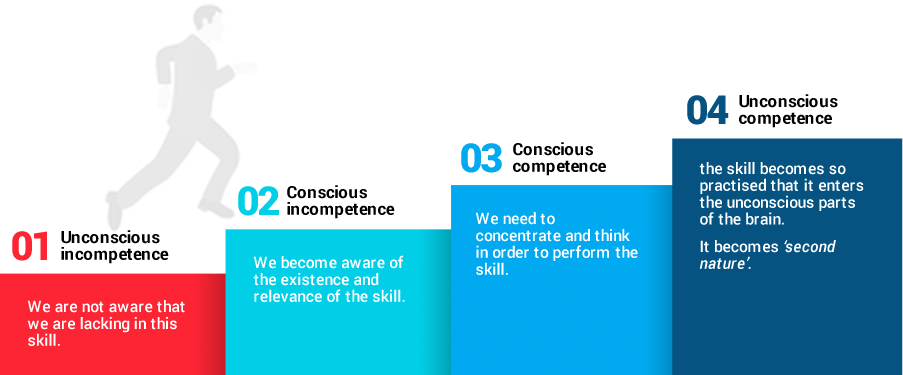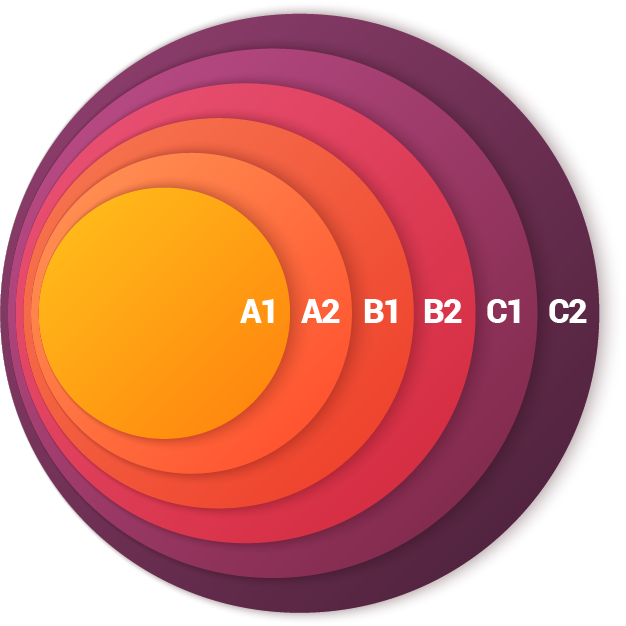Our approach leverages the latest and most practical theories, tools and methodologies to provide our clients with an effective framework for their learning.
At the heart of our personalized approach are the needs of the participants:
Each participant is unique, as is their learning style.
The Conscious Competence Ladder
Because of this uniqueness, we carry out a preliminary conversation to identify the best approach, also with the help of The Conscious Competence Ladder, which is composed of four levels of learning.

Common European Framework of Reference for Languages (CEFR)
The six levels of competence (A1, A2, B1, B2, C1, C2) and the three intermediate levels (A2+, B1+, B2+) of the CEFR are used throughout Europe and provide a reference model for the preparation of teaching materials and for the assessment of language skills.

C2 - Fluency
The Fluency Student can understand almost everything they hear and read without great difficulty. The student is able to summarize information from different sources, both written and oral. In addition, they manage to express themself in a spontaneous, precise and fluent way, and to use linguistic subtleties even in more complex situations. During meetings they are able to take detailed and precise notes, continuing to fully participate in the meeting.
C1 - Advanced
The Advanced student manages to understand a wide range of rather long and complex texts, also perceiving the implicit meanings. In addition, they are able to express themself in a fluent and spontaneous way encountering little difficulty in finding the most appropriate expressions. Typically, they manage to use language in a flexible and effective way in work and social situations. And, lastly, they manage to produce well-structured, clear and articulated texts that deal with complex topics, showing that they know how to control discursive structures and cohesion mechanisms.
B2 - Upper-Intermediate
The Upper-Intermediate student is able to understand the fundamental ideas of complex texts that deal with both concrete and abstract concepts on technical topics in their field of work. They manage to interact with native speakers with relative fluency and spontaneity.
They are also able to produce clear and articulated texts that deal with a wide range of topics, and express opinions and pros and cons on current issues.
B1 - Intermediate
The Intermediate student can understand the essential points of a clearly written message that concerns familiar topics related to work or leisure, etc. They also manage to handle different situations where there are native speakers, and is able to produce simple and coherent texts that deal with familiar topics and of interest.
And, finally, they are able to describe experiences, events and ambitions, as well as express opinions and provide reasoning and explanations on projects and choices.
A2 - Pre-Intermediate
The Pre-Intermediate student can understand common phrases and expressions related to family situations such as providing information about themselves or their family, their city or their work. In addition, they are able to communicate in everyday and family situations that require only a simple exchange.
They manage to describe in simple terms aspects that concern their experience, environments, and immediate needs.
A1 - Elementary
The Elementary student is able to understand and use familiar expressions that concern everyday situations or to satisfy concrete needs. The student is able to introduce themself and others, and is able to ask questions concerning personal information. They are also able to answer questions about themself, where they live, work and their family. They manage to interact in simple situations as long as the interlocutor speaks slowly and clearly.
Are you interested in finding out more? Get in touch!
Do you need more information than you have found on this site? Get in touch with us now and we will get back to you within 24 hours.